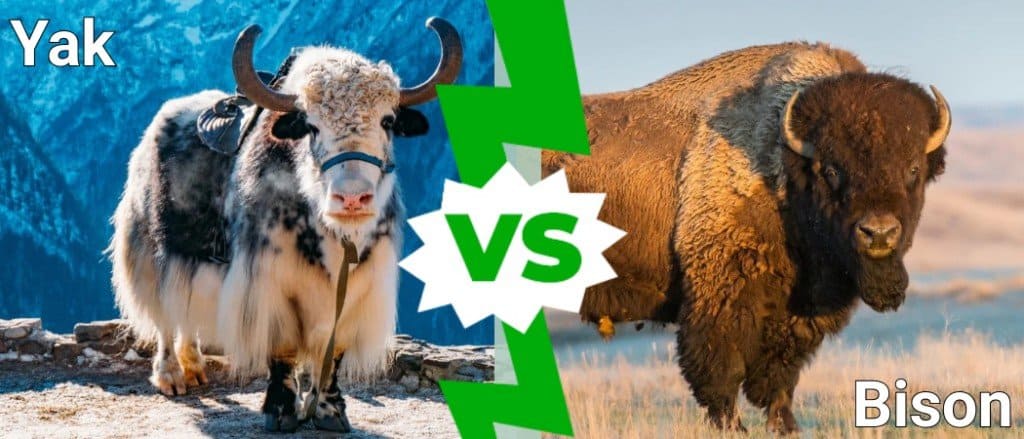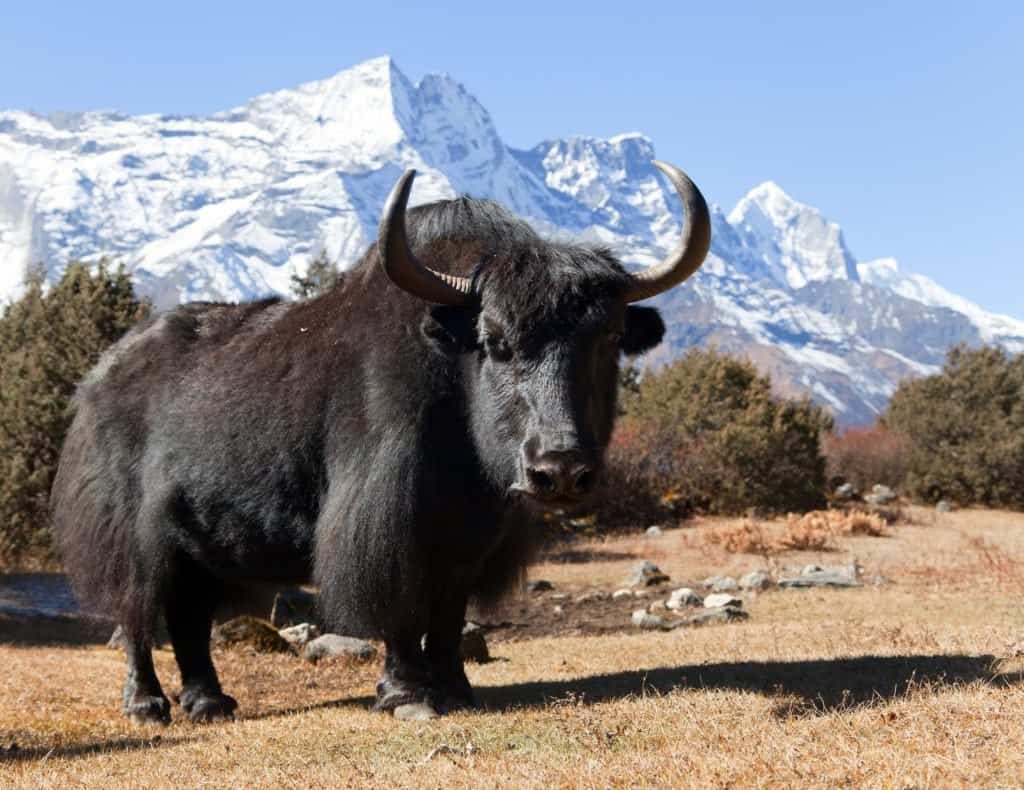Yak vs bison are sometimes confused with each other and they’re actually quite closely related. They are both herbivorous mammals which are often distinguished by their large bodies, humped shoulders, and horns. However, despite their similarities there are some key differences between them.
For a start, they live in very different places and habitats and are often different sizes too. They also have completely different tails and one is a lot hairier than the other. Not only that, but one can be domesticated and has a wide range of uses. But that’s not all, so join us we discover exactly how to tell yaks and bison apart.
Comparing Bison vs Yak

| Bison | Yak | |
| Location | US, Canada, Mexico, Russia, Germany, Belarus, Lithuania, Poland, Switzerland | Northern Tibet, China, India, Nepal, Mongolia, Siberia |
| Habitat | Grassland, river valleys, deciduous and mixed forests | Treeless uplands, meadows, and plateaus between 9,800 and 18,000 feet |
| Size | Weight – 700 to 2,180 pounds Height – 5ft 9in to 6ft 7in at the shoulder | Weight – 500 to 2,600 pounds Height – 3ft 7in to 6ft 7in at the shoulder |
| Color | Dark brown, black | Black, dark brown, cream, brown or cream patches (domesticated yak) |
| Body Shape | Large, heavy body, large head, humped shoulders, shaggy coat, bard under the chin | Heavy body, humped shoulders, sturdy legs, wide forehead, small ears |
| Tail | Short tail with a tuft on the end | Long and made up of individual strands – like a horse’s tail |
| Hair | Soft, dense inner layer with coarse, shaggy outer layer | Long, dense hair on chest, flanks, and belly |
| Predators | Humans, wolves, bears | Himalayan wolves, snow leopards, brown bears |
| Lifespan | 10 to 20 years | Up to 25 years |
The 4 Key Differences Between Yak and Bison

Although wild yak are usually solid colors of black or brown, domesticated yak can also be cream, or a mixture of cream and brown patches, while bison are just brown or black.
©SakSa/Shutterstock.com
There are many key differences between yak and bison. Both bison and yaks live in different parts of the world from one another. Yaks also prefer to live at higher elevations when compared to bison. The overall size and weight differences are subtle, but yaks are slightly larger than bison overall. Finally, yaks have long and hairy tails, while bison tails are short.
Let’s discuss these differences in more detail now.
Yak vs Bison: Habitat

Bison live mainly in grasslands, valleys, and forests, while yaks live at high elevations.
©iStock.com/Jillian Cooper
One of the main differences between yak and bison is where they live. Bison live in grasslands, river valleys, and forests mostly across North America and parts of Europe. However, yak are found in northern Tibet, China, India, Nepal, Mongolia, and Siberia. Wild yak live high up in treeless meadows and plateaus between 9,800 and 18,000 feet. One of their main locations is the Tibetan Plateau.
Yak vs Bison: Appearance
Bison and yak are both large, imposing animals, but their shape differs quite a lot. Bison have heavy bodies with humped shoulders and huge heads. They have a long beard underneath their chin and short, curved horns.
Yak also have a heavy body, sturdy legs, and humped shoulders. However, even though their forehead is wide, their face is typically slimmer when compared to that of a bison, and is shaped more like that of a cow. Yak also have horns but the shape of them differs between genders. Male yak have horns which are 20 to 40 inches long and sweep out from the side of their head before curving forward. Females horns are smaller and range between 11 and 25 inches long and have a more upright shape.

Although both bison and yak have shaggy coats, yaks are actually much, much hairier.
©Igor Lushchay/Shutterstock.com
Yak vs Bison: Hair
Although both bison and yak have shaggy coats, yaks are actually much, much hairier. Bison have a soft but dense inner layer of hair but have a course and shaggy outer layer. Bison are typically dark brown or black color.
Yak have long, dense hair on their chest, flanks, and thighs. However, it is their belly hair which is most impressive as it is incredibly thick and hangs down much lower than the belly. The color of yak also varies more than bison. Although wild yak are usually solid colors of black or brown, domesticated yak can also be cream, or a mixture of cream and brown patches.
Yak vs Bison: Tail

Yaks are have incredibly hairy bellies and a long, full tail like that of a horse, while bison have a tail like a cow.
©Daniel Prudek/Shutterstock.com
The tails of bison and yaks are also vastly different. Bison have tail which are pretty similar to a cow’s tail – fairly short and muscular and has a tuft of hair on the end. However, yak tails are nothing at all like that – instead, they are more like a horse’s tail. Their tails are long and full and are made up of individual strands of hair.
The photo featured at the top of this post is © Michail_Vorobyev/Shutterstock.com
FAQs (Frequently Asked Questions)
Are yak and bison from the same family group?
Yes, wild yak, domesticated yak, and bison are all from the Bovidae family group which is made up of cloven-hoofed ruminant mammals. Other members of the family group are cattle, buffalo, and antelopes.
Are bison dangerous?
Yes, bison are known for being extremely unpredictable and can attack even when unprovoked. They are one of the most dangerous animals in North America and regularly injure more people than bears.
Are wild yaks dangerous?
Although wild yak generally run away when they encounter people, they can attack when they are defending their young. They have also been known to attack and kill domestic yaks.
What are domesticated yaks used for?
Domesticated yaks have a range of uses and are often heavily relied on by the people who keep them. They provide meat and milk as well as wool or fiber from their coats. They are also used for pulling carts and for transporting goods many miles across the country. Even their droppings are useful as they are dried and turned into fuel which is the only fuel available on the Tibetan Plateau.
Thank you for reading! Have some feedback for us? Contact the AZ Animals editorial team.






